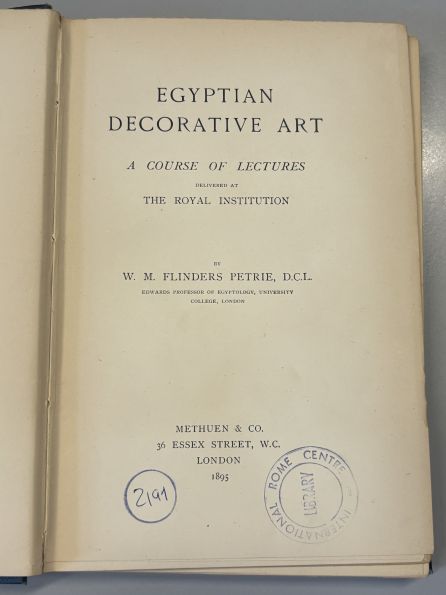رغم حجمه الصغير نسبياً، إلا أن ذلك لا يقلل من أهميته؛ فمجلد الفن الزخرفي المصري: دورة من محاضرات، الذي نُشر في عام 1895، يُعد واحداً من العديد من الكنوز الثمينة التي تمثل قسم الكتب النادرة في مكتبة إيكروم.
مُجلد بغلاف أخضر داكن ويحتوي على 128 صفحة مائلة إلى الاصفرار تحمل عبقاً سحرياً كرائحة أوراق الخريف الماضي، تتناول هذه الدورة من المحاضرات دراسة تطور الزخارف والعناصر الزخرفية المختلفة في مصر القديمة.
فمؤلف المجلد، السيد ويليام ماثيو فليندرز بتري؛ الذي كان أستاذاً في علم الآثار المصرية بكلية لندن الجامعية، يتأمل كيف كان التصميم في مصر القديمة زاخراً بالزخارف، مشيراً إلى حب المصريين القدماء للشكل والرسم.
على مدار أربعة أو خمسة آلاف عام، حافظ المصريون على استخدام الصور (المتضمنة في الكتابة المصورة الأولى) بدلاً من تبني الاختصارات الأسهل، كما فعل الصينيون أو البابليون الأوائل. ورغم أن الشكل الفني قد تغير عبر القرون، إلا أنه بقي ثابتاً في جوهره.
في المجلد، يستعرض فليندرز بتري العناصر الرئيسية المستخدمة في الزخارف المصرية، مصنفاً إياها إلى أربعة تصنيفات، بدءاً بالأشكال الهندسية باعتبارها أولى الزخارف ذات الأهمية في مصر.
ومن ثم الخط المتعرج، وهو أحد أبسط وأقدم أنواع الزخارف. حيث يظهر على القبور القديمة التي تعود إلى حوالي 4,000 عام قبل الميلاد. ومنذ أقدم العصور، كان يتم تكرار هذا النوع من الزخارف بشكل متناسق.
هناك أيضاً الشكل اللولبي أو الملفوف، الذي يُعزى أصله إلى تطور شكل زهرة اللوتس. حيث يقال أنه يمثل تجوال الروح، ويُعتبر واحداً من أهم عناصر الزخرفة المصرية.
أما الأشكال الطبيعية مثل الريش، والزهور، والنباتات والحيوانات، فلم يتم استخدامها بشكل عام إلا في وقت لاحق. فشكل الريش، على سبيل المثال، كان يُستخدم كثيراً على جوانب العروش؛ منذ السلالة الثامنة عشرة (من القرن السادس عشر إلى القرن الثالث عشر قبل الميلاد) حتى الآونة الأخيرة.
قد يبدو استخدام الزهور في الزخرفة أمراً بديهياً، لكن القليل منها فقط تم اعتماده للتزيين. فقد انتشرت زهرة اللوتس على نطاق واسع لدرجة أن البعض اعتبرها مصدر كل الزخارف. بعد ذلك، كانت أكثر الزهور شيوعاً هي البردي، والأقحوان، وزهرة اللبلاب، بالإضافة إلى الكرمة والنخيل. كما تم استخدام الخشب والحجارة في الرسم، وكان الجرانيت الأحمر يُنسخ بشكل متكرر على المداخل الغائرة للقبور.
وبالنسبة لأشكال الحيوانات، كان الوعل هو المفضل في الزخرفة، رغم أنه لم يتم تضمينه في الرسومات حتى الأسرة الثامنة عشرة. كما كانت الطيور موضوعاً شائعاً في الرسومات الزخرفية أيضاً.
عند التطرق إلى الرجال الظاهرين في الزخارف، فنلاحظ أنه في فترة الإمبراطورية (بين القرن السادس عشر والقرن الحادي عشر قبل الميلاد)، تم تضمين صور الأسرى لإبراز قوة الملك. وقد ظهرت هذه الصور لأول مرة خلال التحول الكبير الذي طرأ على الفن المصري عقب الفتوحات الآسيوية.
فبعض أشكال الزخرفة أتت كنتيجة مباشرة للاحتياجات الهيكلية للمباني أو القطع. حيث كان الإطار الخشبي واحداً من أولى الزخارف المستخدمة.
وقد تم استخدام هذا الإطار بشكل مستمر في التماثيل الحجرية عند مداخل القبور، وهذا ما يدل على أن إطاراً أو شبكة من الأعمال الخشبية كانت تُستخدم في شرفات المنازل الكبيرة. فهذا التصميم كان يسمح بدخول الضوء والهواء حتى وإن كان الباب مغلقاً، مما يُظهر مدى ملاءمته للتغيرات المناخية.
تكمن القيمة الحقيقية للزخرفة الهيكلية في الاحتفاظ بها لأغراض الزينة أو الديكور بعد مرور فترة طويلة من فقدان الغرض الهيكلي الأصلي منها. حيث يشير هذا الحفظ إلى حقبة ماضية وظروف اختفت منذ ذلك الحين.
وأخيراً، هناك العديد من الزخارف التي تكررت باستمرار في الأعمال المصرية وكانت تحمل دلالات رمزية.
فأفعى "الأورايُس" أو الكوبرا في غضبها أصبحت شعاراً للملك بفضل كرامة وقوة هذا الحيوان.
وربما يكون رمز الكرة الأرضية والأجنحة، الذي يعود تاريخه إلى بداية العصر المعماري، قد عبر عن نفس فكرة القوة والحياة والموت والحفظ والدمار.
أما الخنفساء، رغم انتشارها الشائع كتميمة، إلا أنها نادراً ما تستخدم في السياقات الرمزية أو الزخرفية.
في الوقت نفسه، يحذرنا المؤلف من "البحث عن معنى خفي في كل زهرة" (وهو ما يسميه "عادة خيالية أوروبية"). فمثلاً، كانت زخارف زهرة اللوتس مجرد عنصر جمالي وليس نباتاً مقدساً.
إن هذا المجلد، المكتوب بلغة بسيطة، يُعد مصدراً ثميناً ليس فقط لعلماء الآثار المصرية، بل أيضاً لأولئك الذين يرغبون في التعرف على الزخارف الفنية في مصر القديمة.
فالمجلد يوضح كيف أن الزخارف كانت انعكاساً للحياة اليومية للمصريين في جوانبها العملية الأكثر واقعية، وأيضاً للطريقة التي تصوروا بها الكون وللمعاني الرمزية التي أضفوها عليه.
لقد عبرت إيكروم عن اهتمامها بحفظ الفن المصري من خلال جمع مجموعة من المواد المنشورة والوثائق ذات الصلة مثل هذه المحاضرات الجميلة. بالإضافة إلى ذلك، عملت أنشطة إيكروم المتعلقة بحفظ الآثار المصرية، والتي بدأت منذ الستينات، على إنتاج مجموعات أرشيفية غنية وقيمة تتألف من المراسلات، وتقارير البعثات، والصور الفوتوغرافية والمواد السمعية والبصرية، فضلاً عن العينات. حيث تحتوي مجموعة عينات مورا على أكثر من 75 عينة من أكثر من 15 معلماً مصرياً، بما في ذلك مقبرة نفرتاري، ومقبرة توت عنخ آمون، ومعابد أبو سمبل.

